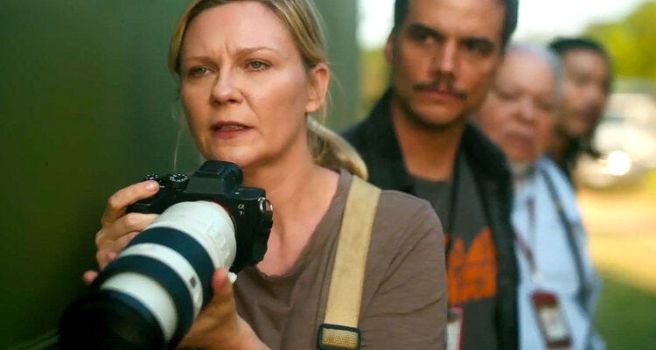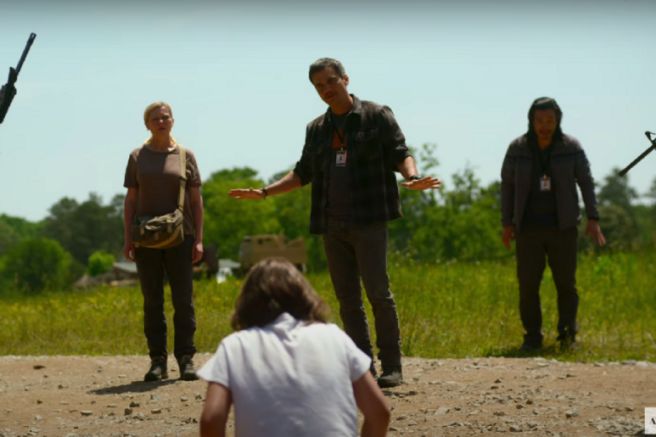Alex Garland’s latest film “Civil War” is a chillingly powerful dystopian war drama. Starting with a grim story promise which may not be that implausible considering the ongoing polarization inside the American society, the movie takes its time for immersing us more into its main characters’ perilous journey across the country torn apart by a civil war, and you will be alternatively amused and horrified by what and how it is about.
The story is mainly told via the viewpoint of a small group of war journalists reporting on the second civil war in US. Mainly due to the president who seems quite dictatorial (He is serving his third term in addition to dissembling FBI, by the way), the country has been divided into several different parts, and you may be amused to see that Texas and California come to band together for fighting against the president despite their considerable social/political differences.
Anyway, the president has declared that his government and military will soon win and then end the war, but many of war journalists working in New York City are understandably skeptical because the country has been going down into more chaos and uncertainty. Not so surprisingly, the value of dollar has gone down to the bottom, and many people in the city are suffering from the frequent lack of food and water while the city is occasionally struck by suicide terror attack. I do not know whether such a dystopian situation can really happen there someday, but, folks, nothing seems totally impossible to us these days, especially after that outrageously shocking political rise of Donald J. Trump.
When her fellow journalist Joel (Wagner Moura) suggests that they should go to Washington D.C. for interviewing the president, Lee (Kirsten Dunst) is reluctant because she does not think that is possible, but she eventually agrees to join Joel along with two other figures: Sammy (Stephen McKinley Henderson) and Jessie (Cailee Spaeny). While Sammy is an older journalist working for the New York Times who has also been Lee’s mentor, Jessie is a young woman willing to learn and experience more via Lee, who has been incidentally a role model for many young female war photographers like Jessie.
As these four different journalists begin their journey across the country, the movie slowly and steadily doles out a series of gloomy moments showing how the country has been ravaged by the ongoing war. We see lots of ruins here and there, and we are horrified to see how the country is filled with numerous dangerous war zones. Think about the horrors of many different modern wars ranging from the Vietnam War to the Israel-Hamas War, and then imagine these horrors being unleashed onto the American society in full scales.
However, the movie takes a rather distant position to the horrors of war just like many other similar war journalism films such as “Under Fire” (1983) or “The Year of Living Dangerously” (1983). To Lee and her fellow journalists, this is just another war to be photographed and reported, and their weary detachment and cynicism are evident from how Garland and his cinematographer Rob Hardy phlegmatically presents several atrocious moments of cruelty and apathy on the screen. Everything in the film is handled with dry and stark objectivity, and that is further accentuated by the sparse score by Ben Salisbury and Geoff Barrow, which mostly sticks to its restrained mode without glorifying anything on the screen.
In the end, the movie becomes more about the gray moral areas of professional journalism, and Lee’s emotional arc comes to take the center along the story. While she is a weary professional who has nearly seen all, she is also reminded that she still has the heart to bleed, and that is how she comes to bond more with Jessie, who probably reminds Lee a lot of who she once was at the beginning of her professional career. Kirsten Dunst, who has been one of the most interesting actresses working in Hollywood during last 30 years, did a good job of embodying her character’s weariness and vulnerability, and Cailee Spaeny makes an interesting contrast with her throughout the film.
In case of Joel and Sammy, they also find themselves affected by the horror of war in one way or another. As a more seasoned professional, Sammy is often quite cautious, but then he finds himself taking a big risk later in the story because, well, he has no other choice from the start. While simply focusing on his ambitious mission, Joel is eventually cornered to his breaking point just like others, and the movie throws more bitter irony upon him around the point when he and others arrive at Washington D.C. at last. While Wagner Moura is effective as his character’s seemingly laid-back attitude crumbles more and more along the story, Stephen McKinley Henderson provides the stable ground for his co-stars, and several notable performers including Nick Offerman and Jesse Plemons are also solid in their brief appearances.
In conclusion, “Civil War” is another compelling work from Garland, who made a stunning directorial debut with “Ex Machina” (2014) and then moved onto “Annihilation” (2018) and “Men” (2022). While it does not reach to the haunting qualities of “Ex Machina” and “Annihilation”, it is relatively more engaging at least than the interesting but ultimately jumbled experiment of “Men”, and I admire how it sticks to Garland’s ambitious vision to the end. In short, this is one of more fascinating movies of this year, and I think you should check it out as soon as possible.










